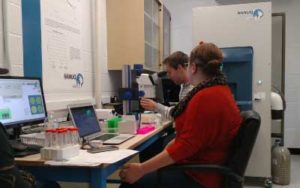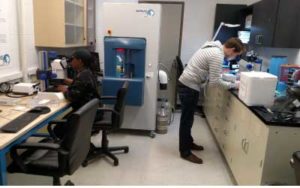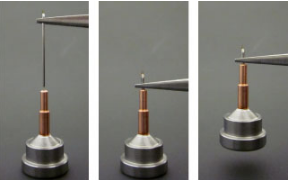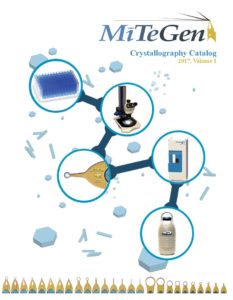
ESRF MX Beamlines, Impact of Loop Choice, & more!
August 2017
BEAMLINE SPOTLIGHT
ESRF's MX Beamlines Upgraded to Have New FlexHCD Sample Changers
(Figure: The FlexHCDs installed on ID23-1 (A) and ID29 (B). (C) The MXCuBE interface showing its generic sample changer brick adapted to the operation of the FlexHCD. (D) In the experimental hutch, a dedicated interface, available as a touchscreen application, allows for the loading/unloading of pucks into the HCD.)
"Robotic sample changers are fundamental devices available on almost all synchrotron-based macromolecular crystallography (MX) beamlines. The ESRF, in close collaboration with the EMBL Grenoble Outstation, was pioneering in the installation of such devices on its MX facilities where a prototype sample changer, SC1, was first tested in 2001. By the end of 2006, all the ESRF MX beamlines were equipped with the SC3 production version. In January 2016, the ESRF Structural Biology Group, again in collaboration with the EMBL Grenoble Outstation, launched the FlexHCD project. The main objective of which was the replacement of the aging SC3s with a new generation of sample changers similar to the FlexHCD that was installed on ID30B in 2015. Two new FlexHCD are already operational on ID23-1 and ID29 and the project will be completed in 2017 with the equipment of the micro-focus beamlines ID23-2 and ID30-A3."
(Project team: ESRF: F. Dobias, H. Caserotto, P. Theveneau, G. Leonard and D. Nurizzo. EMBL: G. Papp, M. Lopez-Marrero, C. Rossi, C. Sorez, F. Cipriani.)
WHY DO MANY CRYSTALS DIFFRACT POORLY?
How Your Crystal Mounting Method Impacts Cryocooling & Diffraction
In crystallography, labs often send hundreds of crystals off for data collection. Many crystals simply do not provide the data quality necessary to solve structures. Why do so many crystals diffract poorly? One cause is the use of outdated tools and methods during harvesting and cryocooling.
MiTeGen’s patented family of MicroMounts and MicroLoops are manufactured from a highly x-ray transparent polymer into precise shapes and sizes using cutting-edge photolithography techniques. These X-ray transparent loops can go directly into the beam, so users select a loop size that is slightly smaller than the crystal and harvest them directly onto the loop's surface. Mounting crystals on the loop simplifies harvesting, decreases damage, and improves cryocooling.
In the end, structures are solved by the quality of diffraction you obtain, not by the number of crystals you send. Start solving structures using the most advanced method for crystal harvesting.

CRYO-EM GRIDS, GRID BOXES & PUCKS
MiTeGen Now Delivers the Leading Cryo-EM Products
LATEST: Cryo-EM Pucks - Simply and Securely Know Where Each Grid Box Is
Simplify how you store and transport your cryogenically cooled Cryo-EM specimen grids. Each puck holds up to 24 round Cryo Grid Boxes (96 grids). A custom serial number on each puck allow easy sample tracking. A 10 puck capacity storage cane is compatible with standard refrigerators, such as the HC34 & HC35. The compatible shelved shipping cane holds 7 pucks and can be used with a CX100 dryshipper.
CRYSTALLOGRAPHY NEWS
New 1:1 and 2:1 salts in the `DL-norvaline–maleic acid' system as an example of assembling various crystal structures from similar supramolecular building blocks
S. G. Arkhipov, E. A. Losev and & E. V. Boldyreva (2017). Acta Crystallographica Section C. 73, 13-19.
The novel compound dimethylamine-5,5′-bistetrazole-1,1′-diolate: crystal structure, thermal investigation, safety evaluation and theoretical studies
Yuehai Yua, Shusen Chena, Xin Lia, Shaohua Jin, Lijie Lia, Guangyuan Zhangb, Xiao Mab & Qinghai Shu (2017). RSC Adv., 2017,7, 18523-18528.
SCHEDULE YOUR ACCESS - NANUQTM
Come Cryocool Your Crystals, Simplify Cryoprotection and Eliminate Ice
(Users from the McKenna Lab, University of Florida, Prepare Samples for Plunge Cooling Tests at MiTeGen's NAF)
The NANUQ™ Access Facility (NAF) is located at MiTeGen's headquarters in Ithaca, NY, USA, just a few miles away from the CHESS synchrotron beamlines. The facility and support services enable crystallographers to access state-of-the-art equipment that will optimize the cryocooling of their crystals, while reducing or eliminating the need for cryoprotectants. The laboratory facility includes a NANUQ™ cryocooling device, liquid nitrogen supplies and accessories, a Carl Zeiss Discovery V8 stereo microscope outfitted for crystallography, and all the required tools and accessories for controlled, reproducible cryocooling into the Universal V1 Pucks (Uni-pucks). MiTeGen personnel are on site to directly assist in ensuring the success of NAF users.
REUSABLE GONIOMETER BASES
MiTeGen Reusable Bases for Crystallography
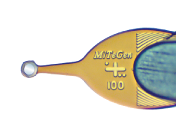
Now that you have the right loops, get started using them quickly with our patented reusable goniometer bases. Our designs grab and securely hold MicroMounts, MicroLoops, and all our standard crystal mounts without epoxy, glue or grease.
Advantages of using MiTeGen Reusable Base:
- Prepare mounts in less than 10 seconds
- No glue required
- Reuse bases again and again
- Style available for all major synchrotron automounters
- Save time for more research
RECEIVE YOUR CRYSTALLOGRAPHY 2017 CATALOG :

Have an idea for a new tool or product, need us to answer a question, or have a comment on our existing products?


